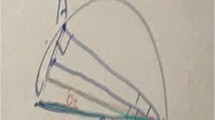Abstract
This study focuses on the constructions in terms of area and perimeter in equivalent triangles developed by students aged 12–15 years-old, using the tools provided by Cabri-Geometry II [Labore (1990). Cabri-Geometry (software), Université de Grenoble]. Twenty-five students participated in a learning experiment where they were asked to construct: (a) pairs of equivalent triangles “in as many ways as possible” and to study their area and their perimeter using any of the tools provided and (b) “any possible sequence of modifications of an original triangle into other equivalent ones”. As regards the concept of area and in contrast to a paper and pencil environment, Cabri provided students with different and potential opportunities in terms of: (a) means of construction, (b) control, (c) variety of representations and (d) linking representations, by exploiting its capability for continuous modifications. By exploiting these opportunities in the context of the given open tasks, students were helped by the tools provided to develop a broader view of the concept of area than the typical view they would construct in a typical paper and pencil environment.
Similar content being viewed by others
Explore related subjects
Discover the latest articles, news and stories from top researchers in related subjects.References
A. Baturo and R. Nason, Student teachers’ subject matter knowledge within the domain of area measurement. Educational Studies in Mathematics 31 (1996) 235-268
T.P. Carpenter, T.G. Coburn, R.E. Reys and J.W. Wilson, Notes from National Assessment: Basic concepts of area and volume. Arithmetic Teacher 22 (1975) 501-507
L. Cohen and L. Manion, Research Methods in Education. London: Routledge (1989).
Douady, R. and Perrin, M.-J. (1986). Concerning conceptions of area (students aged 9 to 11). Proceedings of the 10th International Conference, Psychology of Mathematics Education, London, England, pp. 253–258
K.-M. Hart, Measurement. In: J. Murray (ed.) Students Understanding of Mathematics: 11–16. G. Britain: Athenaeum Press Ltd (1989) pp. 9-22
L. Healy and C. Hoyles, Software tools for geometrical problem solving: Potentials and pitfalls. International Journal of Computers for Mathematical Learning 6 (2001) 235-256
Holzl, Using dynamic geometry software to add contrast to geometric situations – a case study. International Journal of Computers for Mathematical Learning 6 (2001) 3-86
Kidman, G. and Cooper, T. J. (1997). Area integration rules for grades 4, 6, and 8 students. Proceedings of the 21st International Conference, Psychology of Mathematics Education, Vol. 3, Lathi, Finland, pp. 136–143
M. Kordaki and D. Potari, A learning environment for the conservation of area and its measurement: A computer microworld. Computers and Education 31 (1998) 405-422
M. Kordaki and D. Potari, The effect of area measurement tools on student strategies: The role of a computer microworld. International Journal of Computers for Mathematical Learning 7 (2002) 1-36
M. Kordaki, The effect of tools of a computer microworld on students’ strategies regarding the concept of conservation of area. Educational Studies in Mathematics 52 (2003) 177-209
J.-M. Laborde, Cabri-Geometry [Software]. France: Université de Grenoble (1990.).
C. Laborde and J.-M. Laborde, What about a learning environment where Euclidean concepts are manipulated with a mouse?. In: A. diSessa, C. Hoyles, R. Noss and L. Edwards (eds.) Computers and Exploratory Learning. Berlin: Springer-Verlag (1995) pp. 241-261
Maher, C. A. and Beattys, C. B. (1986). Examining the construction of area and its measurement by ten to fourteen year old students. In E. Lansing, G. Lappan and R. Even (Eds), Proceedings of the 8th International Conference, Psychology of Mathematics Education, N.A., pp. 163–168
M.A. Mariotti, Justifying and proving in the Cabri environment. International Journal of Computers for Mathematical Learning 6 (2001) 257-281
Moreira Baltar, P. (1997). Learning Process for the Concept of Area Planar Regions in 12–13 year-olds. Proceedings of the 21st International Conference, Psychology of Mathematics Education, Vol. 3, Lathi, Finland, pp. 264–271
T. Nunes, P. Light and J. Mason, Tools for thought: The measurement of length and area. Learning and Instruction 3 (1993) 39-54
J. Piaget, B. Inhelder and A. Szeminska, The Child’s Conception of Geometry. NY: Norton & Company (1981).
Tierney, C., Boyd, C. and Davis, G. (1986). Prospective primary teachers’ conceptions of area. 10th PME Conference, pp. 307–315
Author information
Authors and Affiliations
Corresponding author
Rights and permissions
About this article
Cite this article
Kordaki, M., Balomenou, A. Challenging Students to View the Concept of Area in Triangles in a Broad Context: Exploiting the Features of Cabri-II. Int J Comput Math Learning 11, 99–135 (2006). https://doi.org/10.1007/s10758-005-5380-z
Published:
Issue Date:
DOI: https://doi.org/10.1007/s10758-005-5380-z




